In today’s digital age, your art needs a platform where it shines and grabs attention. Remember a time when you saw a piece of art that deeply moved you. You felt a strong connection to the creator’s vision. Now, think of your work making someone feel that way. A well-made artist website can do just that. It’s more than a portfolio online; it’s a space where viewers really connect with your artwork. Here, we’ve picked out the best artist websites for inspiration. You’ll see everything from simple designs to colorful galleries. Each website shows what makes an artist’s site stand out. Let’s dive into these amazing websites and see what ideas they might spark for your art.
Key Takeaways
- The article features a total of 25 artist websites exemplifying excellent web design.
- The websites showcase a range of design styles, appealing to diverse artistic preferences.
- All websites serve as virtual portfolios to connect artists with audiences.
- Clear navigation and engaging content enhance user experience across featured sites.
- Mobile optimization is necessary, catering to a growing number of users browsing on mobile devices.
Why Having an Artist Website is Essential
These days, having an artist website is super important. It’s like your own spot on the internet where you can show off your art. People can see what you create, learn about your art journey, and check out what you’re selling, all in one cool place.
When you make your art available online, people see you as a true professional. If you don’t have a website, some might think you’re not serious about your art. A slick website shows off your skills and that you’re up to date with tech, which is what people expect now.
Having a website isn’t just about showing your art; it’s also about being in charge of your story and how you sell your work. You can sell art anytime with an online shop. Blogs can help people find your site more easily. And through email newsletters, you can connect with your fans better than on social media, letting them know about your new art and shows.
In a world full of artists, your own website makes you shine. It boosts your chances to reach more people and share your talent. For any artist wanting to succeed today, a website is a must-have for sharing your art with the world.
The Impact of a Well-Designed Website on Art Exposure
A well-designed artist website is key to increasing art exposure. About 85% of art professionals find it crucial for artists to have an online presence. This shows the need for a great platform to display your work.
A top-notch website can make artists 70% more visible. This visibility is important for their marketing strategies.
When a website looks good, visitors want to explore more. Nearly 90% of art buyers check out artists online before buying. This fact shows how website design affects viewer interest. Improve your site by paying attention to layout, colors, and fonts. This makes it welcoming.
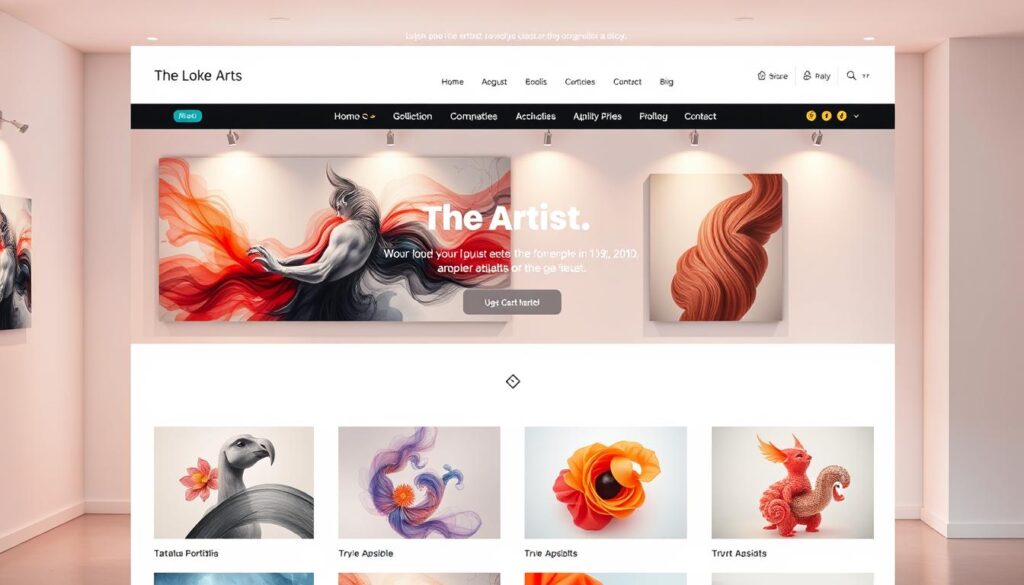
Artists with blogs or active online sites see a 50% jump in web traffic. Sharing your art journey and connecting with buyers increases interest. It also helps you tell your brand’s story.
The art scene is changing fast. Soon, over 70% of people will view art on mobile devices. It’s important for artists to make their websites easy to use on phones and tablets. This helps viewers enjoy your work no matter where they are.
| Statistic | Impact |
|---|---|
| 85% of art professionals | Consider absence of a website unacceptable |
| 70% visibility increase | With a well-designed website |
| 90% of buyers | Research artists online before purchases |
| 50% traffic increase | For artists engaging through blogs |
| 70% of users | Will access content via mobile devices by 2025 |
Key Features of the Best Artist Websites
To make a great website as an artist, focus on a few important features. These features can really help people find you online and buy your art. It’s not just about showing your art. Your site should make it easy for buyers to see and connect with your art. To really stand out online, make sure to include these key features.
High-Quality Portfolio Display
The core of an artist’s website is the portfolio. A quality portfolio shows off your art talent well. Use high-resolution images to draw people in and let them see your work up close. A stunning portfolio not only displays your art well but also boosts your website’s search ranking by a lot. High-quality images make people 75% more likely to engage with what they see.
Easy Navigation for Users
Having a site that’s easy to use is very important. Clear and simple navigation makes for a better visit. It helps people quickly find what they need. Websites that are easy to move around in are preferred by 70% of users. A good layout leads people smoothly through your art, about you, and how to contact you. Keep menu options to a minimum to avoid confusing your visitors and encourage them to look around more.
Mobile Optimization
More than half of users like to browse on mobile devices. Making your artist site mobile-friendly is a must to reach a lot of people. Mobile-friendly sites keep viewers longer and can increase sales. Your site should load fast on phones and be easy to use. A responsive design meets the needs of many art buyers who shop directly from artists’ sites.
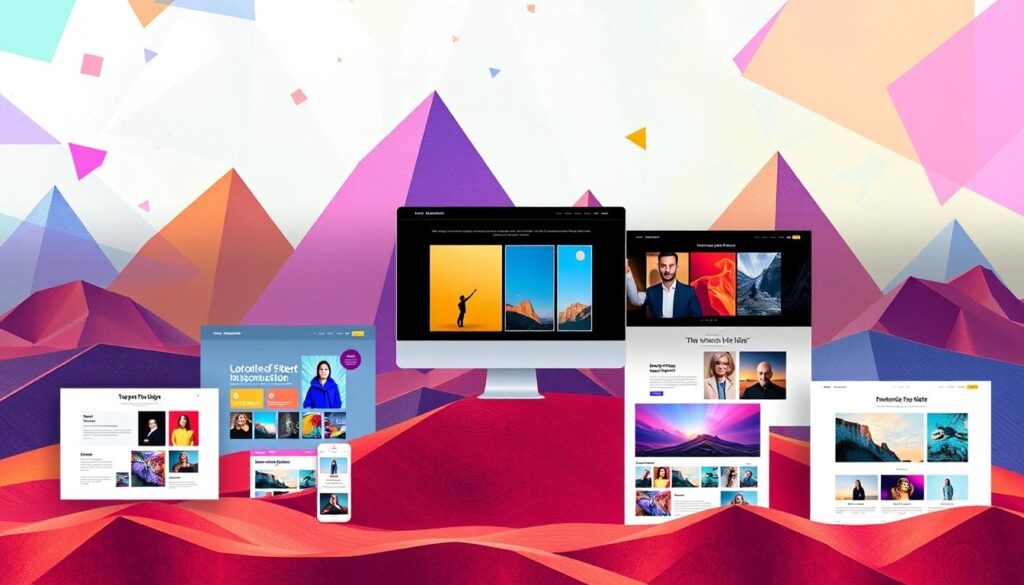
| Feature | Benefits | Statistics |
|---|---|---|
| High-Quality Portfolio | Captivates visitors | 50% increase in SEO effectiveness |
| Easy Navigation | Enhances user experience | 70% of users prefer simple navigation |
| Mobile Optimization | Engages mobile users | 52% of web traffic comes from mobile devices |
Top Picks: Best Artist Websites
Looking at the top artist websites on Squarespace, Shopify, and Format offers great tips for a solid online presence. These platforms give artists special tools to share their work and meet their fans. Here are some of the best examples, showing what makes each platform good for artists.
Made With Squarespace: Showcasing Artistic Talents
Squarespace is loved by many artists for its eye-catching templates. These templates help make portfolios that really draw in viewers. By using Squarespace’s stunning designs, you can make your art stand out online.
Made With Shopify: Ecommerce Integration for Artists
Shopify shines when it comes to selling art online. It combines a sleek gallery look with tools to sell your work smoothly. Features like inventory management and payment processing make Shopify a great pick for artists entering the online sales world.
Made With Format: Clean and Modern Designs
Format stands out for its clean and modern website designs. It’s perfect for artists who want their art to be the main focus. Format’s websites are easy to navigate and let your art tell its story, presenting it in a professional way.
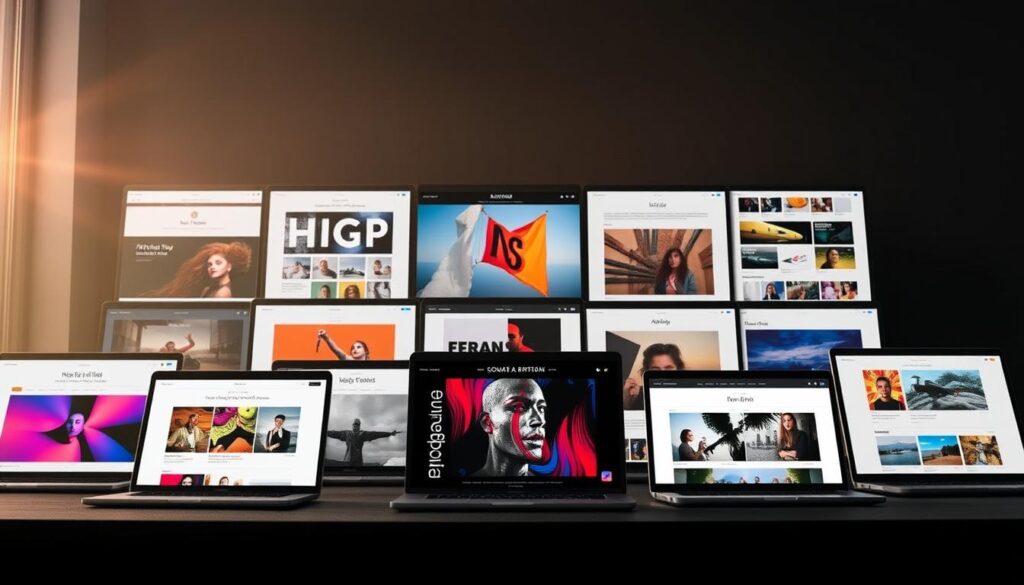
Inspiring Examples of Artist Websites
Looking at artist websites offers loads of inspiration. They show creativity and how to present art effectively. These sites come in many artistic styles and designs. They help any artist wanting to upgrade their online look. Let’s dive into some artist portfolios that really catch the eye.
Feature Example: Samantha’s Unique Artistic Perspective
Samantha’s site starts with a striking full-page image. It draws you in fast. Her art tells stories, showing her unique vision. This way of showing art grabs viewers and shares her deep artistic ideas beautifully.
Feature Example: Benjamin’s Striking Photography
Benjamin’s website is all about simplicity. His stunning photos are the main show. With a clean design, his art shines brightest. His site reminds us that simple can be powerful. It really highlights an artist’s skill.
Feature Example: Maegan’s No-Nonsense Portfolio
Maegan’s site gets straight to the point. It’s easy for viewers to look through her art. Her layout and design focus on showcasing creativity well. It stands as a great model for an artist portfolio that spotlights the art.
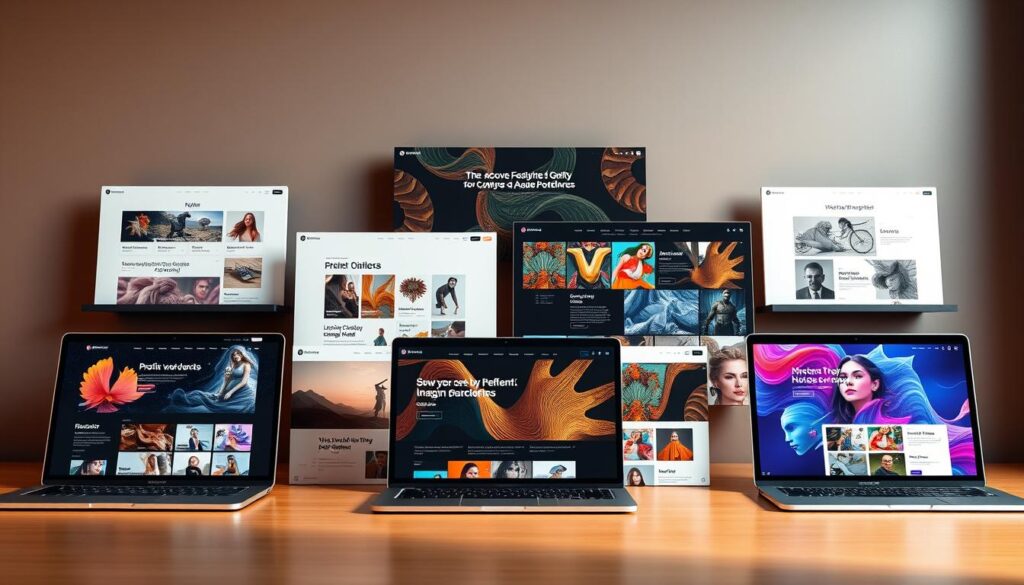
What Makes an Artist Website Stand Out?
When you set up your artist website, a few key things help you stand out. A well-made site boosts how users feel and shows off your artistic voice. You’ll make a big impact on how people see and interact with your work by using clear visuals and strong personal branding.
Visual Hierarchy and Clarity
It’s crucial to have a visual hierarchy to lead visitors to the important parts of your site. By smartly organizing your content, you make sure people notice your art and key info first. For example, a consistent design that matches what you create makes your projects easy to understand. Use different visuals for varied works and clear section markers to help people navigate. A gallery layout works great for focusing on one thing, while a simple design helps with showing off bigger or more detailed works without distractions.
Personal Branding and Artist Narrative
The story of your art is key in linking up with your fans. Your personal branding shows how you tell your story to those who visit. An engaging about page is often a hit, sharing your creative drive and what pushes you. Keep updating your work to keep the story new, and share your path to build a community. Good storytelling makes you more known, creating deep bonds with future buyers and art lovers.
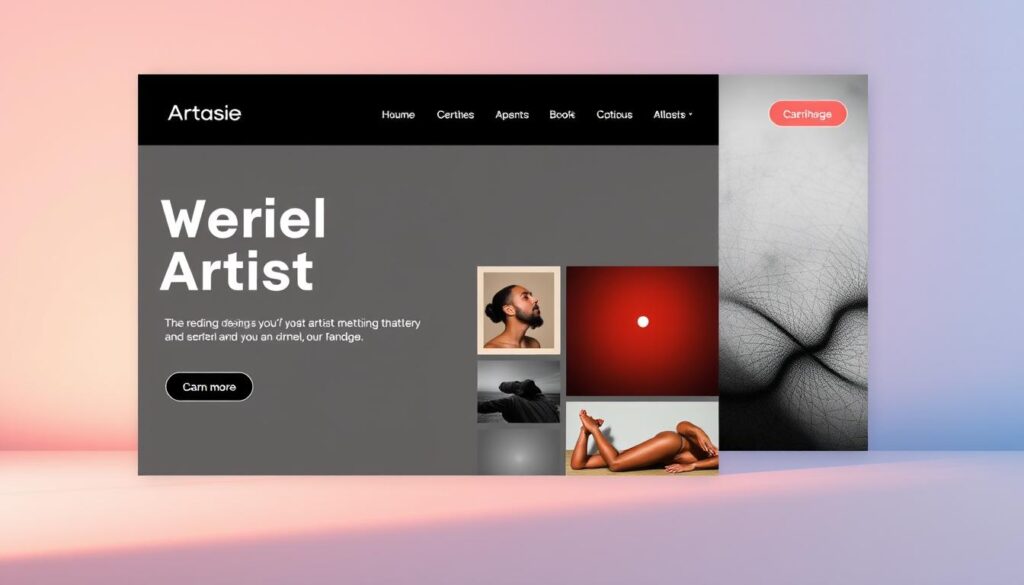
| Aspect | Importance | Best Practices |
|---|---|---|
| Visual Hierarchy | Guides visitor attention | Use clear headings and organized layouts |
| Cohesive Design | Supports artistic medium | Maintain a unified theme across the site |
| Personal Branding | Enhances viewer connection | Tell your story through site content |
| Regular Updates | Keeps content relevant | Update at least once or twice a year |
Pros and Cons of Different Website Builders for Artists
As an artist, finding the right website builder is key to how you show up online. It’s about picking between platforms like Squarespace and Shopify by knowing what they offer. We’ll look at the good and bad of each to help you decide.
Squarespace vs. Shopify: Which is Better for You?
For artists picking a website builder, Squarespace and Shopify each have their ups and downs. They let you build a site that truly shows off your creativity.
| Feature | Squarespace | Shopify |
|---|---|---|
| Pricing | Starting at $16/month (billed annually) | Starting at $29/month |
| Template Variety | Over 100 art-focused templates | Limited templates due to its ecommerce focus |
| Design Flexibility | Highly customizable, user-friendly | Rigid structure, less creative freedom |
| Ecommerce Features | Built-in, with additional costs | Robust tools for selling art |
| Best For | Showcasing art and personal branding | Artists prioritizing sales and ecommerce |
Many artists think Squarespace looks best for sharing their work. It focuses on design with templates that make artwork stand out. Shopify, meanwhile, is great for selling art online. Still, artists often wonder which platform will best meet their needs.

Building Your Own Artist Website: A Quick Guide
Creating a website for your art can be very rewarding. It shows off your art and connects you with people. This process becomes easier and works better with a good plan. For artists wanting to start, knowing how to pick the right platform and design a great portfolio page is key.
Selecting the Right Platform
Choosing the right platform is important when making an artist website. There are many options like Squarespace, Wix, Shopify, and Dorik. They offer different features for artists. Think about your budget, how much you want to customize, and if you plan to sell art online. Squarespace is user-friendly and great for lots of images, and Shopify is best for selling online. While free platforms may be tempting, they often don’t offer good SEO tools. This can make your site hard to find in search results.
Designing Your Portfolio Page
Your portfolio page is very important on your website. It needs to show off your art well. To create an engaging page, follow these design tips for artists:
- High-Quality Images: Use clear and bright pictures of your art. This looks good and helps with SEO.
- Clear Navigation: Make sure visitors can easily look through your artwork. Using categories or filters can help.
- Descriptions: Talk about your art. Giving details can interest viewers and make them value your work more.
- Responsive Design: A lot of people use mobile devices for browsing. Make sure your website works well on any device.
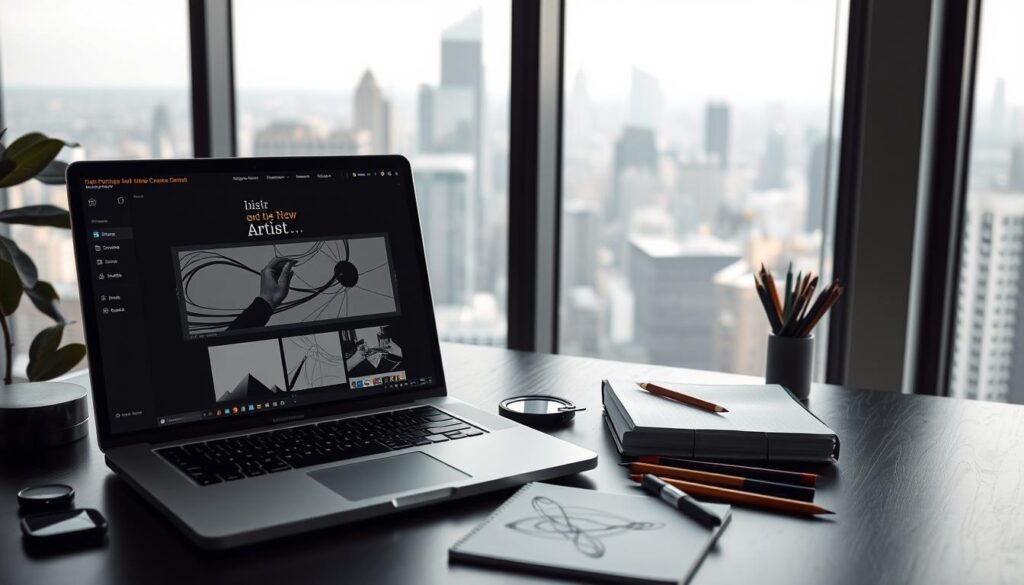
Engaging Your Audience Through Blogs and Newsletters
For any artist seeking growth, connecting with your audience is key. Using blogs for artists and newsletters for creatives allows you to bond more with your art community. These platforms let you share stories and updates that truly speak to your followers through artistic storytelling.
Benefits of Sharing Your Artistic Journey
Regular posts through blogs and newsletters build a strong community feel. They keep your fans up-to-date on your latest creations and happenings. Being real and open about your artistic path engages your audience, drawing them closer into your world.
- Encouraging feedback and comments can spark discussions, making your audience feel valued.
- Offering exclusive content, such as behind-the-scenes glimpses or early access to new pieces, enhances engagement.
- Regular updates can keep your audience excited about your work, encouraging them to share your content with others.
Artistic storytelling does more than share your perspective; it makes your brand more humane. This personal approach is crucial in attracting an engaging art audience that craves real connections with artists.
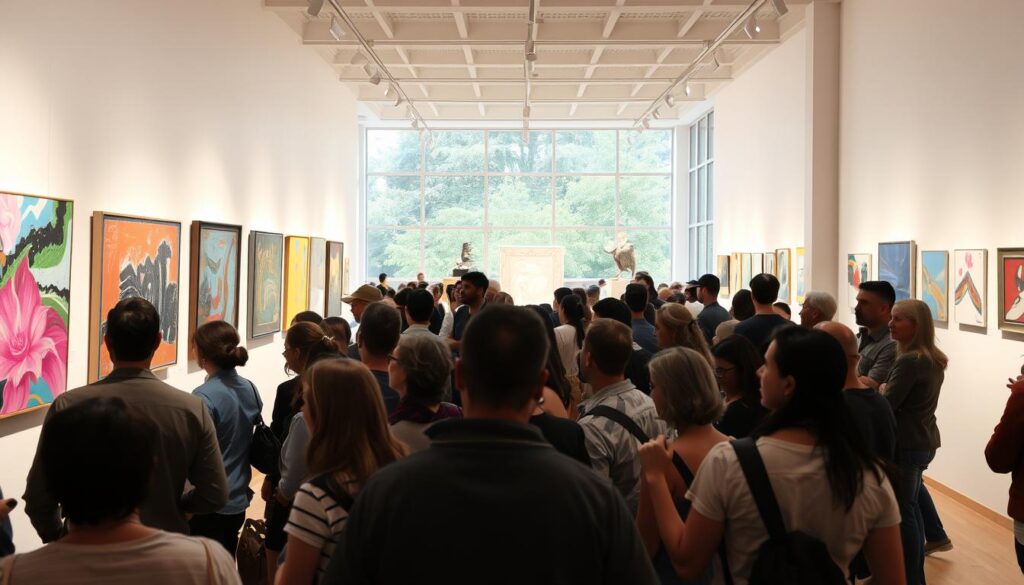
Conclusion
When we talk about artist websites, having a strong online presence isn’t just nice to have, it’s a must. Every great artist website focuses on showing off their work with beautiful, high-quality images. This captures the attention of visitors and makes them feel closer to the art. Also, 80% of these sites are easy to move around in, letting art lovers and potential buyers look through galleries without trouble.
Thinking about your online image shows that a little time spent on your website can go a long way. Three out of four artists have an “About” page, giving their site a personal touch that pulls in visitors. What’s more, 60% of these websites let people buy art right from the site. This turns their creative work into a way to earn money.
So, as artists consider these points, it’s good to see your website as more than some tech project. It’s your chance to make a lively, appealing space that displays what you do best. Your website should adapt to phones and computers alike and include fun ways for people to interact with your art. This opens up so many doors to show your work to the world.









